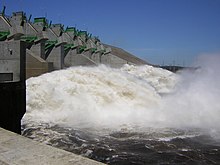Energy in Venezuela

Venezuela was one of the world's largest producers of oil, and the country with the largest proven oil reserves in the world. Venezuela is a member of OPEC.
Electricity in Venezuela is predominantly produced from hydroelectricity.
Overview
| Capita | Prim. energy | Production | Export | Electricity | CO2-emission | |
|---|---|---|---|---|---|---|
| Million | TWh | TWh | TWh | TWh | Mt | |
| 2004 | 26.1 | 653 | 2,280 | 1,623 | 72.1 | 128 |
| 2007 | 27.5 | 741 | 2,138 | 1,381 | 84.6 | 144 |
| 2008 | 27.9 | 745 | 2,102 | 1,340 | 85.9 | 146 |
| 2009 | 28.4 | 778 | 2,367 | 1,503 | 89.5 | 155 |
| 2010 | 28.83 | 895 | 2,241 | 1,353 | 94.77 | 183.04 |
| 2012 | 29.28 | 816 | 2,335 | 1,506 | 97.73 | 159.22 |
| 2012R | 29.96 | 888 | 2,318 | 1,405 | 101.88 | 178.28 |
| 2013 | 30.41 | 800 | 2,235 | 1,405 | 98.25 | 155.57 |
| Change 2004-10 | 10.3% | 37.0% | -1,7% | -16,6% | 31.4% | 42.6% |
| Mtoe = 11.63 TWh, Prim. energy includes energy losses
2012R = CO2 calculation criteria changed, numbers updated | ||||||
Oil
Venezuela ranked 11th in the world for oil production in 2016; production has since fallen steeply.[2] The largest oil company is Petróleos de Venezuela (PDVSA). Oil fields in the country include Bolivar Coastal Field, Boscán Field, Maracaibo Basin and Orinoco Belt.
In 2023, Venezuela held the world's largest proven oil reserves at 303 billion barrels, accounting for 17% of global reserves, mostly extra-heavy crude from the Orinoco Belt. Despite this, production was only 0.8% of the global total, dropping to 742,000 barrels per day, a 70% decline from 2013. Production rose by 13% in 2021 and 18% in 2022 with help from Iran, China, and Chevron after some sanctions were eased. PDVSA, the state oil company, faces issues like heavy government levies, underinvestment, mismanagement, and a lack of skilled personnel, reducing reinvestment and production. Refineries operate below capacity due to maintenance issues and lack of feedstock. Venezuela relies on fuel imports from Iran and China due to domestic shortages. A territorial dispute with Guyana over the Essequibo region heightened tensions, but both countries agreed to seek a diplomatic resolution.[3]
Electricity

Hydroelectricity
Hydro power provided 74% of domestic electricity in 2008. Venezuela produced 87 TWh hydro power in 2008, 2.6% of the world total. Venezuela was top 8th in hydro electricity in 2008.[4]
See also
References
- ^ IEA Key World Energy Statistics Statistics 2015 Archived 4 March 2016 at the Wayback Machine, 2014 (2012R as in November 2015 Archived 5 April 2015 at the Wayback Machine + 2012 as in March 2014 is comparable to previous years statistical calculation criteria, 2013 Archived 2 September 2014 at the Wayback Machine, 2012 Archived 9 March 2013 at the Wayback Machine, 2011 Archived 27 October 2011 at the Wayback Machine, 2010 Archived 11 October 2010 at the Wayback Machine, 2009 Archived 7 October 2013 at the Wayback Machine, 2006 Archived 12 October 2009 at the Wayback Machine IEA October, crude oil p. 11, coal p. 13 gas p. 15
- ^ "Venezuela's Oil Production Set for Another Drop".
- ^ "Petroleum and other liquids". www.eia.gov. 8 February 2024.
 This article incorporates text from this source, which is in the public domain.
This article incorporates text from this source, which is in the public domain.
- ^ IEA Key energy statistics 2010 Archived 11 October 2010 at the Wayback Machine Page: Country specific indicator numbers from page 48
